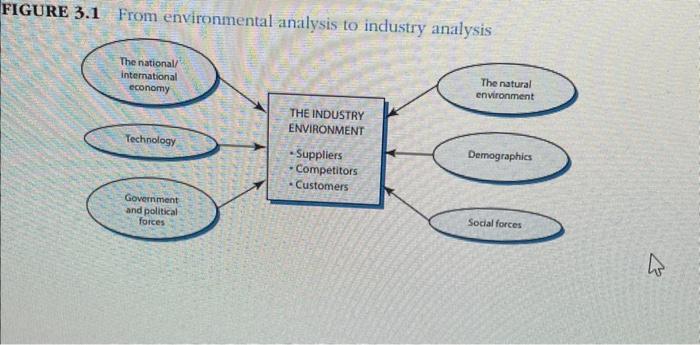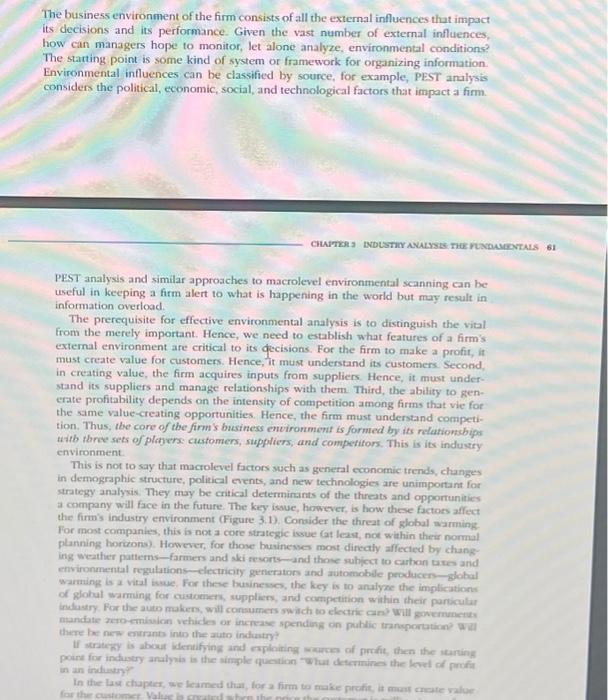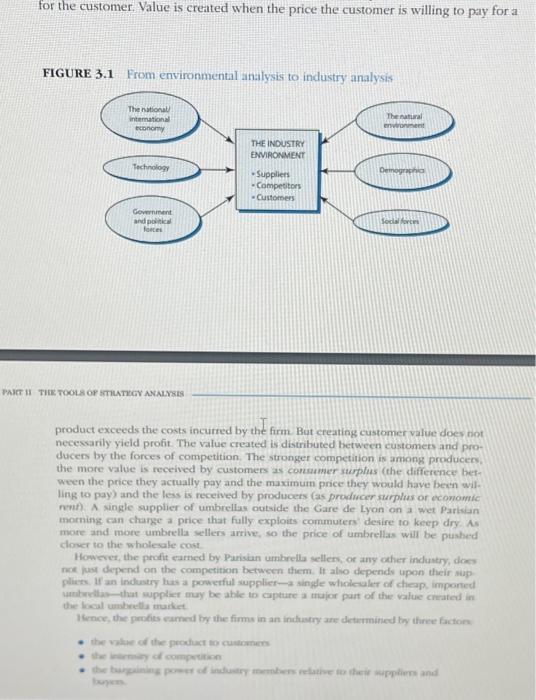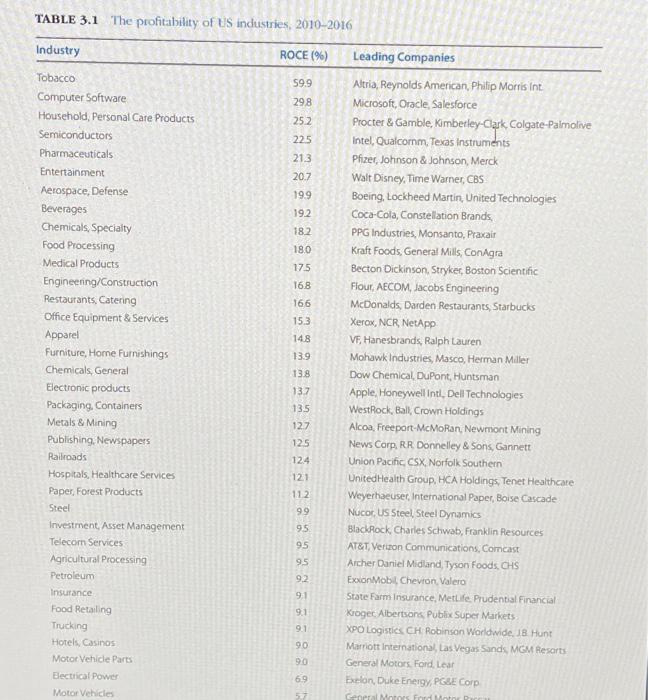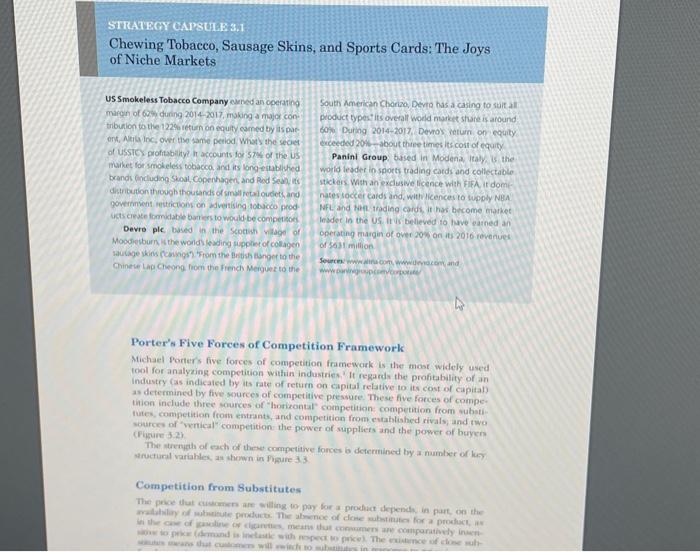please answer questions using textbook pictures and charts

TABLE 3.1 The profitability of ES industries 20n2ma Among the industries listed in Table 3.1 in Chapter 3. which would you consider to be the most "hyper-competitive" (i.e, ones in which competitive advantage and market leadership are frequently overturned)? FIGURE 3.1 From environmental analysis to industry analvsis for the customer. Value is created when the price the customer is willing to pay for a FIGURE 3.1 From environmental analysis to industry analysis II THE TOOLS OF ITHATECV ANALYSIS product exceeds the costs incurred by the firm But creating customer value does tiot necessarily yield protit. The value created is distributed between customers and produces by the forces of competition. The stronger competition is among producers, the more value is received by customers as consumer suplus (the difference between the price they actually pay and the maximum price they would have been wil. ling to pay) and the less is received by producers (as prodiccer surplus or ecomomic rwin. A single supplier of umbrellas outside the Gare de Lyon on a wer Parisian moining ean charge a price that fully exploits commuters' desire to keep dry. As more and more umbrella sellers arrive, so the price of umbrellas will be pushed clover to the wholesale cost Howeves, the profit eamed by Parisian umbrella sellen, of any other induatry, does not just depend on the competition between them. It also depends upon their sup plies. If an industry has a powerful supplier-a single whokeuler of cheap imponted uaturellas - duat wuppler muy be able is capture a major part of the value created in the liscal umbetla market. - the inemary af comperition STRAWBCY CAPSULE 3.1 Chewing Tobacco, Sausage Skins, and Sports Cards: The Joys of Niche Markets US Smokeless Tobacco Company ciened an coeraring marcin of 62 w duning 20142017, muking a major contribution to the 122% ietirn on equity camed by as par. of USSIC profitability? it accounts for 57% of the is Trakes for smokeless tobacco, and its longentubliched distreution throvgh thousands of small retal oudets, and government intrictooms on divenising tobucico prod. ucts creve formidable borrers to would be competicos: Devre ple based in the Scoctish wage of Chinete Lag Cheong from the french Mergues to the South American Chorizo, Devto has a casing to suit al product typest its overall wodd morket share is around 60\%o Duing 2014+2017, Devnos heturn on equity ercecded 20%-about thine times its cosit of equity Panini Group based in Modena italy, is the world lesder in spoets trading catds and collectable stickers. With an excluswe licence with fik it dome nates soccer catds and, with licences to Wophy NEA Insdec in the US it ur bedieved to hwe pained an operating margin of over 20% on its 2016 mevenues of 5931 million Porter's Five Forces of Competition Framework Michael Porter's five forces of competition framewark is the most widely used towl for analyzing competition within industries," It regards the profitability of an industry Gas indicaled by its rate of return on capital relative to its cost of capisat? as determined by hive sources of competitive pressute. These five forces of compe. thion include three sources of "horizontul" competition competioion from wabsil tutes, competition fosh entrunts, and competition from cutablished rivals; and two sources of wrnical competition the power of suppliets and the power of buyen (Plgare $2.2) The strugth of each of these competitive forces b determined by a number of kn aructiand variahlex, an shown in fleare 3.3 Competition from Substitutes The business environment of the firm consists of all the external influences that impact its decisions and its performance. Given the vast number of external influences, how can managers hope to monitor, let alone analyze, environmental conditions? The starting point is some kind of system or framework for organizing information. Environmental influences can be classified by source, for example, PEST analysis considers the political, economic, social, and technological factors that impact a fim. PEST analyxis and similar approaches to macrolevel environmental scanning can be useful in keeping a firm alert to what is happening in the world but may result in information overload. The prerequisite for effective environmental analysis is to distinguish the vital from the merely important. Hence, we need to establish what features of a firm's external environment afe critical to its qecisions. For the firm to make a profit, it must create value for customers. Hence, it must understand its customers. Second, in creating value, the firm acquires inputs from suppliers. Hence, it must understand its suppliers and manage relationships with them. Third, the ability to generate profitability depends on the intensity of competition among firms that vie for the same value-creating opportunities. Hence, the firm must understand competition. Thus, the core of tbe firm s business environment is formed by its relationsbips aitb three sets of plabers customers, suppliers, and competitor. This is its industry environment. This is not to say that macrolevel factors such as general economic trends, changes in demographic structure, political events, and new technologies are unimportant for strategy analyxis. They may be critical determinants of the threats and opportunities a company will face in the future. The key issue, however, is how these factors affect the firm's industry environment (Figure 3.1.). Consider the threat of global warming. For most companies, this is not a core stratcgic issue Gat least, not within their normal planning horzons). However, for those businesses most directly affected by changing weather patterns-farmers and ski mosts-and those subject to carton tases and environmental regututions-electricity generators and automobile peoducers-global sarming is a vital iswe, For these businesses, the key is to analyse the implications of giohul warming for custoesers, supplies, and costipetition wishin their particular industry. For the auto makers, will consumers swich to electric can' will govermunetes there be new entrants inte the auto indastry? poine for indusery analynis is the simple quostion "What determines the koet of profit in an indusery? In the lav chuptex, we leamed that, for a firm to make prodic


